Related Research Articles
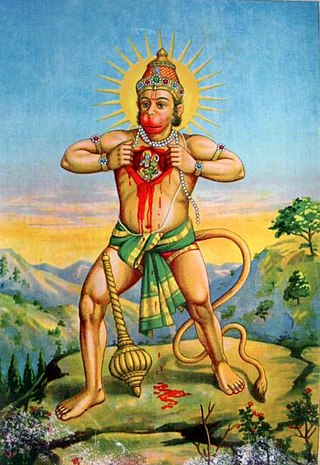
Hanuman, also known as Maruti, Bajrangabali, and Anjaneya, is a deity in Hinduism, revered as a divine vanara and a devoted companion of the deity Rama. Central to the narrative of the Ramayana, Hanuman is celebrated for his unwavering devotion to Rama and is considered a chiranjivi. He is traditionally believed to be the spiritual offspring of the wind deity Vayu, who is said to have played a significant role in his birth. His tales are recounted not only in the Ramayana but also in the Mahabharata and various Puranas.

Rambola Dubey popularly known by his title Tulsidas or Goswami Tulsidas, was a Vaishnava Hindu saint and poet, renowned for his devotion to the deity Rama. He wrote several popular works in Sanskrit, Awadhi, and Braj, but is best known as the author of the Hanuman Chalisa and of the epic Ramcharitmanas, a retelling of the Sanskrit Ramayana based on Rama's life in the vernacular Awadhi.
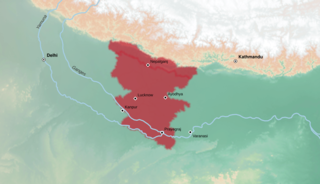
Awadhi, also known as Audhi (औधी), is an Indo-Aryan language spoken in the Awadh region of Uttar Pradesh in northern India. The name Awadh is connected to Ayodhya, the ancient city, which is regarded as the homeland of the Hindu god Rama. It was, along with Braj, used widely as a literary vehicle before being displaced by Hindi in the 19th century.

Ramcharitmanas, is an epic poem in the Awadhi language, based on the Ramayana, and composed by the 16th-century Indian bhakti poet Tulsidas. This work is also called, in popular parlance, Tulsi Ramayana, Tulsikrit Ramayana, Tulsidas Ramayana or simply Manas. The word Ramcharitmanas literally means "Lake of the deeds of Rama". It is considered one of the greatest works of Hindu literature. The work has variously been acclaimed as "the living sum of Indian culture", "the tallest tree in the magic garden of medieval Indian poetry", "the greatest book of all devotional literature" and "the best and most trustworthy guide to the popular living faith of the Indian people".

The Hanuman Chalisa is a Hindu devotional hymn (stotra) in praise of Hanuman. It is an Awadhi language text attributed to Tulsidas, and is his best known text apart from the Ramcharitmanas. The word "chālīsā" is derived from "chālīs", which means the number forty in Hindi, as the Hanuman Chalisa has 40 verses.

Morari Bapu is an Indian spiritual leader and narrator of Rama katha from Gujarat. He is an exponent of Ramcharitmanas with more than 900 kathas recited over the last 60 years. Bapu's core message is truth, love, and compassion (satya-prem-karuna) and encouraging awareness about Hindu scriptures.

Camille Bulcke was a Belgian Jesuit missionary in India who came to be known as "India's most renowned Christian Hindi scholar".

Ramlila is any dramatic folk re-enactment of the life of Rama according to the ancient Hindu epic Ramayana or secondary literature based on it such as the Ramcharitmanas. It particularly refers to the thousands of the Hindu god Rama-related dramatic plays and dance events, that are staged during the annual autumn festival of Navaratri in India. After the enactment of the legendary war between good and evil, the Ramlila celebrations climax in the Vijayadashami (Dussehra) night festivities where the giant grotesque effigies of evil such as of the rakshasa (demon) Ravana are burnt, typically with fireworks.
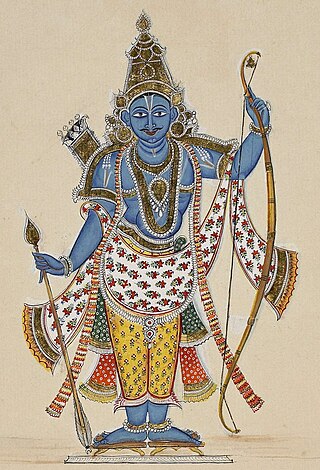
Rama is a major deity in Hinduism. He is the seventh and one of the most popular avatars of Vishnu. In Rama-centric traditions of Hinduism, he is considered the Supreme Being.

Jagadguru Ramanandacharya Swami Rambhadracharya is an Indian Hindu spiritual leader, educator, Sanskrit scholar, polyglot, poet, author, textual commentator, philosopher, composer, singer, playwright and Katha artist based in Chitrakoot, India. He is one of four incumbent Jagadguru Ramanandacharya, and has held this title since 1988.
Tulsi Peeth Seva Nyas is an Indian religious and social service institution based at Janki Kund, Chitrakoot, Madhya Pradesh, India. It was established by the Hindu religious leader Jagadguru Rambhadracharya on August 2, 1987. Rambhadracharya believes that this Peeth is situated at the place where the Hindu god Rama gave his sandals to his brother Bharat.

This timeline lists important events relevant to the life of the Vaishnava (Hindu) spiritual leader, poet, commentator, educationist, religious and social figure Rambhadracharya.
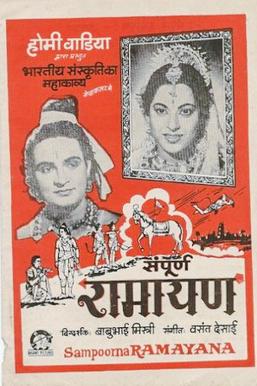
Sampoorna Ramayana is a 1961 Indian Hindi-language Hindu mythological film directed by Babubhai Mistry, based on the Hindu epic Ramayana by Valmiki, starring Mahipal and Anita Guha as Rama and Sita respectively. The film was a box office hit, and became a milestone in the history of Hindu mythology. It was the second significant Hindi film based on Rama, after Vijay Bhatt's hugely popular Ram Rajya (1943). Babubhai, known for his special effects throughout his career, made extensive use of effects to enhance dramatics. The film also made lead actor Anita Guha, who played the role of Sita, a household name. Lata Mangeshkar sang two of the most top-class semi-classical songs in this movie, namely "San Sanan, Sanan, Sanana, Ja Re O Pawan" and "Badalon Barso Nayan Ki Or Se", which are still very popular.

Araṇya-Kāṇḍa, or The Forest Episode, is the third book of the epic poem of Ramayana. It is also found in the Rāmcaritmānas. It follows the legend of Rama through his fourteen-year exile in the forest, joined by his wife and his brother. Rama overcomes challenges and demons by upholding standards of behavior. Nearing the end of his exile, Rama's wife Sita is kidnapped by the king Ravana, and Rama learns what happened. The story continues in the next book, Kiśkindhā Kāṇḍ.
The Murty Classical Library of India began publishing classics of Indian literature in January 2015. The books, which are in dual-language format with the original language and English facing, are published by Harvard University Press. The Columbia University scholar, Sheldon Pollock, is the library's general editor. Pollock previously edited the Clay Sanskrit Library. The library was established through a $5.2 million gift from Rohan Murty, the son of Infosys co-founder N. R. Narayana Murthy and social worker and author Sudha Murty. The series will include translations from Bengali, Gujarati, Hindi, Kannada, Marathi, Punjabi, Sanskrit, Tamil, Telugu, Urdu, other Indian languages and Persian. It will include fiction, poetry, nonfiction, and religious texts from all Indian traditions including Buddhism and Islam. The projected 500 volumes, to be published over a century, have a corpus of thousands of volumes of classic Indian literature to draw on.
Tulsi Manas Mandir is one of the most famous temples in the holy city of Varanasi. This temple has great historical and cultural importance in Hinduism since the ancient Hindu epic Ramcharitmanas was originally written at this place by Hindu poet-saint, reformer and philosopher Goswami Tulsidas in the 16th century.
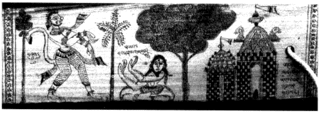
Kalanemi is a rakshasa mentioned in various adaptations of the Hindu epic Ramayana. He is the son of Maricha, who was tasked by Ravana, the epic's main antagonist to kill Hanuman. Although not part of Valmiki Ramayana, his encounter with Hanuman has been described in several versions, but at last he was defeated by Hanuman.

Jai Siya Ram is a Hindi expression, translating as "Glory to Sita and Rama". Sociologist Jan Breman states that it was used as "a greeting of welcome in the countryside since time immemorial".
References
- 1 2 3 4 "Philip Lutgendorf, Professor of Hindi and Modern Indian Studies at the University of Iowa, to speak at KU on February 28th, 2014". University of Kansas. 21 February 2014. Retrieved 15 June 2015.
- ↑ Chidanand Rajghatta (30 April 2014). "Inspired by Mumbai slum dweller's chai, Oprah Winfrey launches swish tea". Times of India . Retrieved 15 June 2015.
- ↑ "Indiana University to open Gateway-India office in Gurgaon". India TV. 12 February 2013. Retrieved 15 June 2015.
- 1 2 "Philip Lutgendorf, PhD '87 on Chai Why? The Making of the Indian 'National Drink'". University of Chicago. Retrieved 17 June 2015.
- 1 2 3 "Philip A. Lutgendorf". University of Iowa . Retrieved 17 June 2015.
- ↑ Metcalf, Barbara; Metcalf, Thomas (2012). A Concise History of Modern India (3rd, revised ed.). Cambridge University Press. p. 311. ISBN 9781139537056 . Retrieved 17 June 2015.
- ↑ Bakker, Freek (2009). The Challenge of the Silver Screen: An Analysis of the Cinematic Portraits of Jesus, Rama, Buddha and Muhammad . BRILL. pp. 102, 126. ISBN 9789004168619.
- ↑ "Morari Bapu Official Website". www.moraribapu.org. Retrieved 2017-06-26.